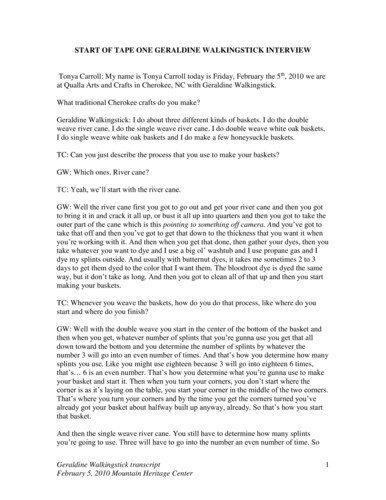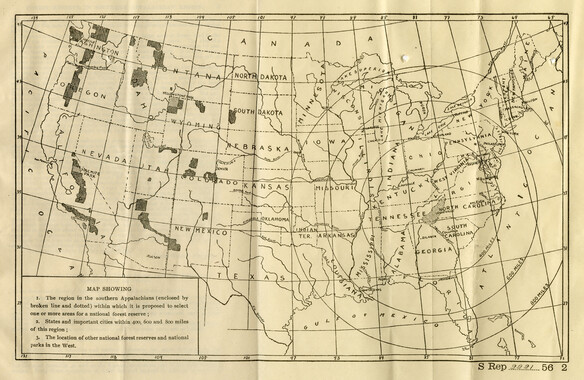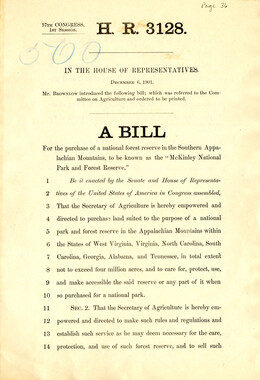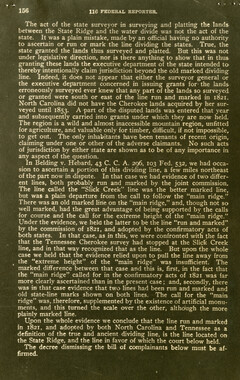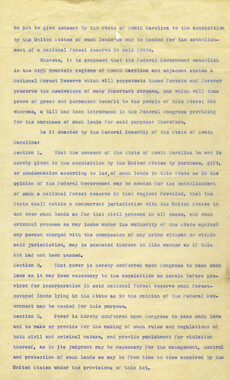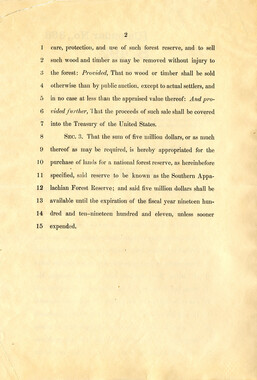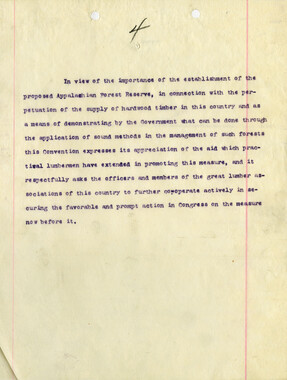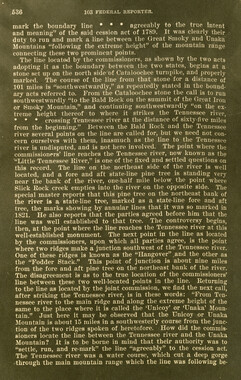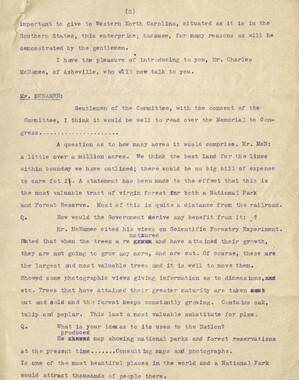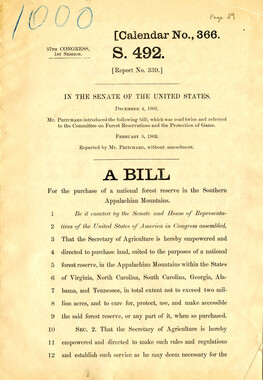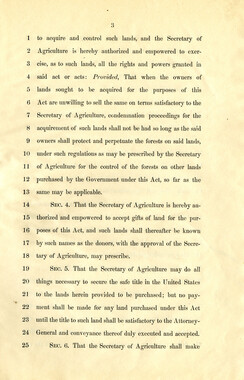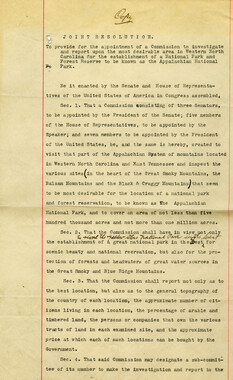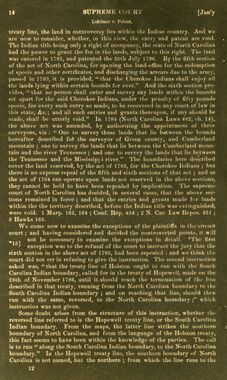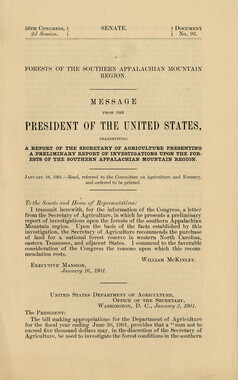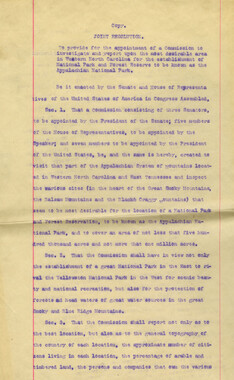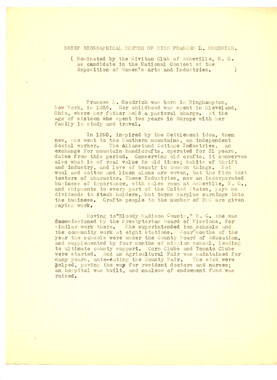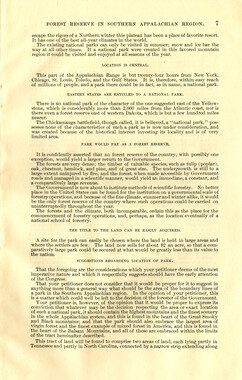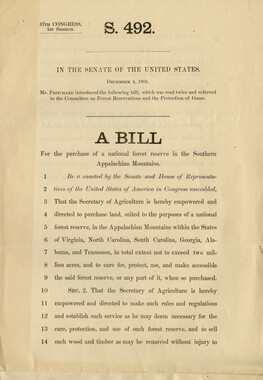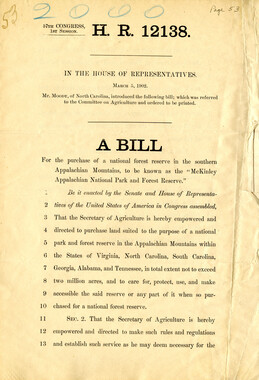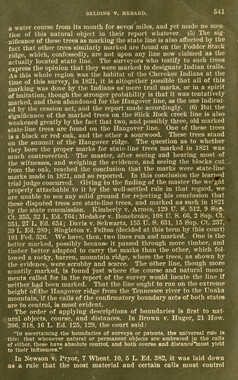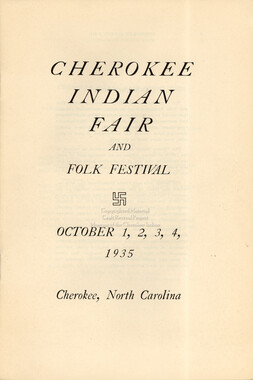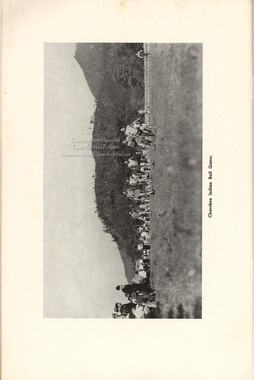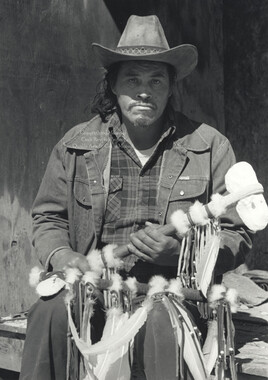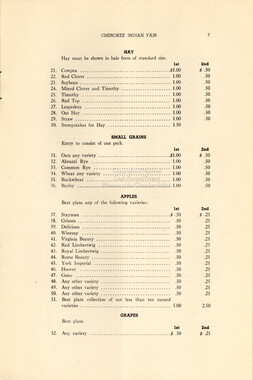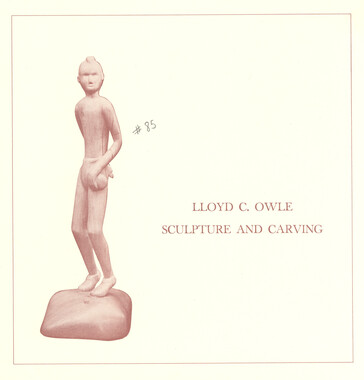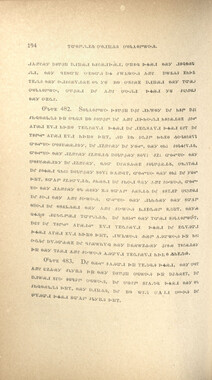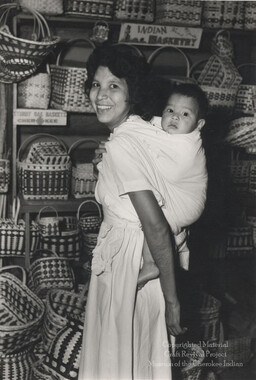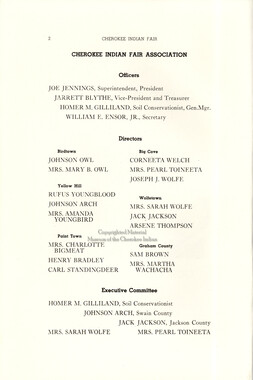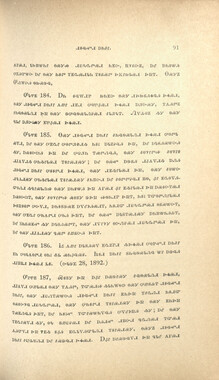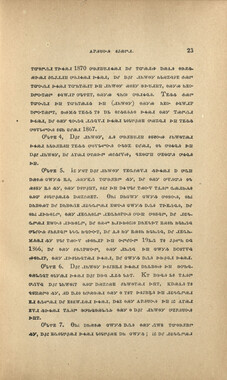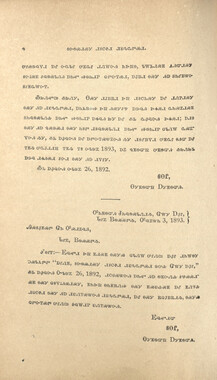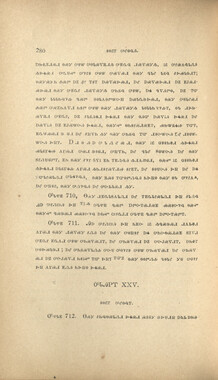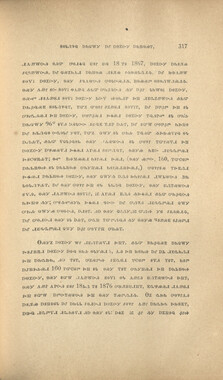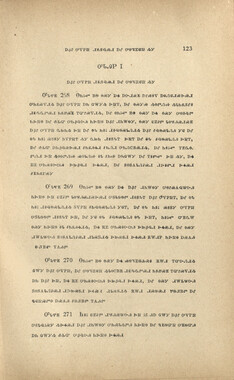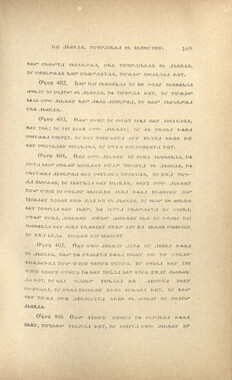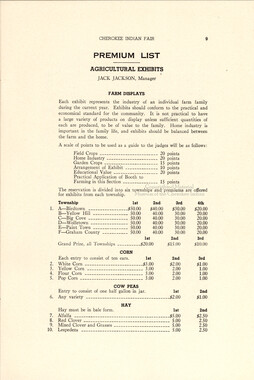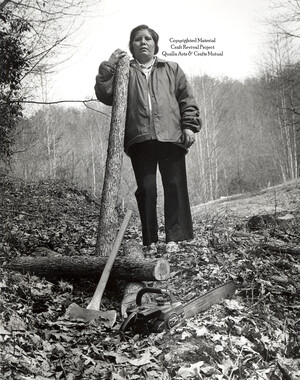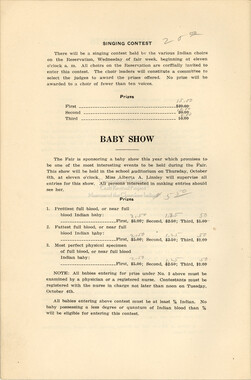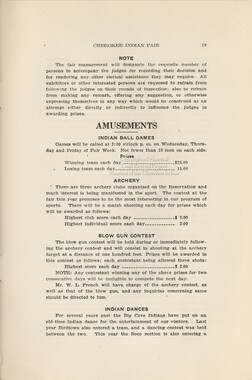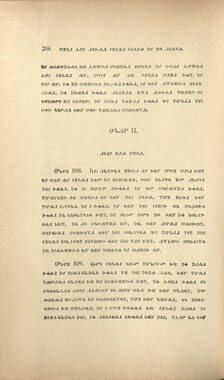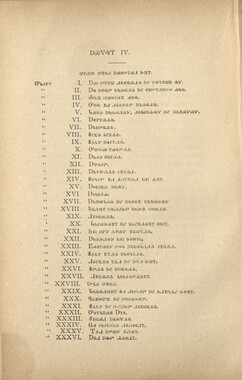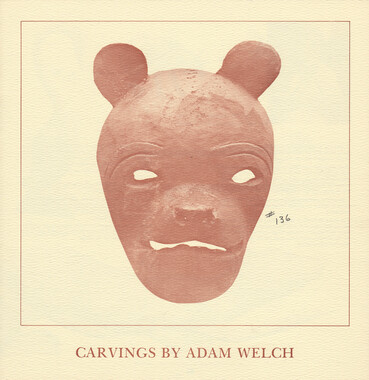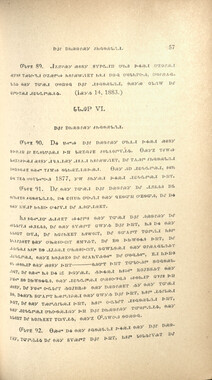Western Carolina University (20)
View all
- Canton Champion Fibre Company (2308)
- Cherokee Traditions (292)
- Civil War in Southern Appalachia (165)
- Craft Revival (1942)
- Great Smoky Mountains - A Park for America (2766)
- Highlights from Western Carolina University (430)
- Horace Kephart (941)
- Journeys Through Jackson (154)
- LGBTQIA+ Archive of Jackson County (85)
- Oral Histories of Western North Carolina (314)
- Picturing Appalachia (6772)
- Stories of Mountain Folk (413)
- Travel Western North Carolina (160)
- Western Carolina University Fine Art Museum Vitreograph Collection (129)
- Western Carolina University Herbarium (92)
- Western Carolina University: Making Memories (708)
- Western Carolina University Publications (2283)
- Western Carolina University Restricted Electronic Theses and Dissertations (146)
- Western North Carolina Regional Maps (71)
- World War II in Southern Appalachia (131)
University of North Carolina Asheville (6)
View all
- Cherokee Indian Fair Association (16)
- Cherokee Language Program (22)
- Roberts, Vivienne (15)
- Southern Highland Handicraft Guild (1)
- United States. Indian Arts and Crafts Board (65)
- Western Carolina University. Mountain Heritage Center (12)
- Allanstand Cottage Industries (0)
- Appalachian National Park Association (0)
- Bennett, Kelly, 1890-1974 (0)
- Berry, Walter (0)
- Brasstown Carvers (0)
- Cain, Doreyl Ammons (0)
- Carver, George Washington, 1864?-1943 (0)
- Cathey, Joseph, 1803-1874 (0)
- Champion Fibre Company (0)
- Champion Paper and Fibre Company (0)
- Crittenden, Lorraine (0)
- Crowe, Amanda (0)
- Edmonston, Thomas Benton, 1842-1907 (0)
- Ensley, A. L. (Abraham Lincoln), 1865-1948 (0)
- Fromer, Irving Rhodes, 1913-1994 (0)
- George Butz (BFS 1907) (0)
- Goodrich, Frances Louisa (0)
- Grant, George Alexander, 1891-1964 (0)
- Heard, Marian Gladys (0)
- Kephart, Calvin, 1883-1969 (0)
- Kephart, Horace, 1862-1931 (0)
- Kephart, Laura, 1862-1954 (0)
- Laney, Gideon Thomas, 1889-1976 (0)
- Masa, George, 1881-1933 (0)
- McElhinney, William Julian, 1896-1953 (0)
- Niggli, Josephina, 1910-1983 (0)
- North Carolina Park Commission (0)
- Osborne, Kezia Stradley (0)
- Owens, Samuel Robert, 1918-1995 (0)
- Penland Weavers and Potters (0)
- Rhodes, Judy (0)
- Roth, Albert, 1890-1974 (0)
- Schenck, Carl Alwin, 1868-1955 (0)
- Sherrill's Photography Studio (0)
- Smith, Edward Clark (0)
- Southern Highlanders, Inc. (0)
- Stalcup, Jesse Bryson (0)
- Stearns, I. K. (0)
- Thompson, James Edward, 1880-1976 (0)
- USFS (0)
- Vance, Zebulon Baird, 1830-1894 (0)
- Weaver, Zebulon, 1872-1948 (0)
- Western Carolina College (0)
- Western Carolina Teachers College (0)
- Western Carolina University (0)
- Whitman, Walt, 1819-1892 (0)
- Wilburn, Hiram Coleman, 1880-1967 (0)
- Williams, Isadora (0)
- 1800s (2)
- 1890s (6)
- 1900s (7)
- 1910s (1)
- 1920s (3)
- 1930s (13)
- 1940s (37)
- 1950s (12)
- 1960s (7)
- 1970s (38)
- 1980s (10)
- 1990s (2)
- 2000s (3)
- 2010s (38)
- 1600s (0)
- 1700s (0)
- 1810s (0)
- 1820s (0)
- 1830s (0)
- 1840s (0)
- 1850s (0)
- 1860s (0)
- 1870s (0)
- 1880s (0)
- 2020s (0)
- Appalachian Region, Southern (258)
- Buncombe County (N.C.) (2)
- Jackson County (N.C.) (1)
- Qualla Boundary (285)
- Asheville (N.C.) (0)
- Avery County (N.C.) (0)
- Blount County (Tenn.) (0)
- Cherokee County (N.C.) (0)
- Clay County (N.C.) (0)
- Graham County (N.C.) (0)
- Great Smoky Mountains National Park (N.C. and Tenn.) (0)
- Haywood County (N.C.) (0)
- Henderson County (N.C.) (0)
- Knox County (Tenn.) (0)
- Knoxville (Tenn.) (0)
- Lake Santeetlah (N.C.) (0)
- Macon County (N.C.) (0)
- Madison County (N.C.) (0)
- McDowell County (N.C.) (0)
- Mitchell County (N.C.) (0)
- Polk County (N.C.) (0)
- Rutherford County (N.C.) (0)
- Swain County (N.C.) (0)
- Transylvania County (N.C.) (0)
- Watauga County (N.C.) (0)
- Waynesville (N.C.) (0)
- Yancey County (N.C.) (0)
- Clippings (information Artifacts) (1)
- Fiction (general Genre) (3)
- Fliers (printed Matter) (3)
- Interviews (12)
- Newsletters (1)
- Photographs (208)
- Poetry (1)
- Publications (documents) (45)
- Sound Recordings (22)
- Video Recordings (physical Artifacts) (12)
- Aerial Photographs (0)
- Aerial Views (0)
- Albums (books) (0)
- Articles (0)
- Artifacts (object Genre) (0)
- Bibliographies (0)
- Biography (general Genre) (0)
- Cards (information Artifacts) (0)
- Crafts (art Genres) (0)
- Depictions (visual Works) (0)
- Design Drawings (0)
- Drawings (visual Works) (0)
- Envelopes (0)
- Facsimiles (reproductions) (0)
- Financial Records (0)
- Glass Plate Negatives (0)
- Guidebooks (0)
- Internegatives (0)
- Land Surveys (0)
- Letters (correspondence) (0)
- Manuscripts (documents) (0)
- Maps (documents) (0)
- Memorandums (0)
- Minutes (administrative Records) (0)
- Negatives (photographs) (0)
- Newspapers (0)
- Occupation Currency (0)
- Paintings (visual Works) (0)
- Pen And Ink Drawings (0)
- Periodicals (0)
- Personal Narratives (0)
- Plans (maps) (0)
- Portraits (0)
- Postcards (0)
- Programs (documents) (0)
- Questionnaires (0)
- Scrapbooks (0)
- Sheet Music (0)
- Slides (photographs) (0)
- Songs (musical Compositions) (0)
- Specimens (0)
- Speeches (documents) (0)
- Text Messages (0)
- Tintypes (photographs) (0)
- Transcripts (0)
- Vitreographs (0)
- Cherokee Studies Collection (4)
- Horace Kephart Collection (1)
- Judaculla Rock project (2)
- Qualla Arts and Crafts Mutual Collection (12)
- A.L. Ensley Collection (0)
- Appalachian Industrial School Records (0)
- Appalachian National Park Association Records (0)
- Axley-Meroney Collection (0)
- Bayard Wootten Photograph Collection (0)
- Bethel Rural Community Organization Collection (0)
- Blumer Collection (0)
- C.W. Slagle Collection (0)
- Canton Area Historical Museum (0)
- Carlos C. Campbell Collection (0)
- Cataloochee History Project (0)
- Daisy Dame Photograph Album (0)
- Daniel Boone VI Collection (0)
- Doris Ulmann Photograph Collection (0)
- Elizabeth H. Lasley Collection (0)
- Elizabeth Woolworth Szold Fleharty Collection (0)
- Frank Fry Collection (0)
- George Masa Collection (0)
- Gideon Laney Collection (0)
- Hazel Scarborough Collection (0)
- Hiram C. Wilburn Papers (0)
- Historic Photographs Collection (0)
- Humbard Collection (0)
- Hunter and Weaver Families Collection (0)
- I. D. Blumenthal Collection (0)
- Isadora Williams Collection (0)
- Jesse Bryson Stalcup Collection (0)
- Jim Thompson Collection (0)
- John B. Battle Collection (0)
- John C. Campbell Folk School Records (0)
- John Parris Collection (0)
- Kelly Bennett Collection (0)
- Love Family Papers (0)
- Major Wiley Parris Civil War Letters (0)
- Map Collection (0)
- McFee-Misemer Civil War Letters (0)
- Mountain Heritage Center Collection (0)
- Norburn - Robertson - Thomson Families Collection (0)
- Pauline Hood Collection (0)
- Pre-Guild Collection (0)
- R.A. Romanes Collection (0)
- Rosser H. Taylor Collection (0)
- Samuel Robert Owens Collection (0)
- Sara Madison Collection (0)
- Sherrill Studio Photo Collection (0)
- Smoky Mountains Hiking Club Collection (0)
- Stories of Mountain Folk - Radio Programs (0)
- The Reporter, Western Carolina University (0)
- Venoy and Elizabeth Reed Collection (0)
- WCU Gender and Sexuality Oral History Project (0)
- WCU Mountain Heritage Center Oral Histories (0)
- WCU Oral History Collection - Mountain People, Mountain Lives (0)
- WCU Students Newspapers Collection (0)
- Western North Carolina Tomorrow Black Oral History Project (0)
- William Williams Stringfield Collection (0)
- Zebulon Weaver Collection (0)
- Artisans (125)
- Cherokee art (18)
- Cherokee artists -- North Carolina (10)
- Cherokee language (21)
- Cherokee pottery (27)
- Cherokee women (140)
- Civilian Conservation Corps (U.S.) (1)
- Forced removal, 1813-1903 (1)
- Storytelling (4)
- Weaving -- Appalachian Region, Southern (1)
- Wood-carving -- Appalachian Region, Southern (14)
- African Americans (0)
- Appalachian Trail (0)
- Church buildings (0)
- College student newspapers and periodicals (0)
- Dams (0)
- Dance (0)
- Education (0)
- Floods (0)
- Folk music (0)
- Forest conservation (0)
- Forests and forestry (0)
- Gender nonconformity (0)
- Great Smoky Mountains National Park (N.C. and Tenn.) (0)
- Hunting (0)
- Landscape photography (0)
- Logging (0)
- Maps (0)
- Mines and mineral resources (0)
- North Carolina -- Maps (0)
- Paper industry (0)
- Postcards (0)
- Pottery (0)
- Railroad trains (0)
- Rural electrification -- North Carolina, Western (0)
- School integration -- Southern States (0)
- Segregation -- North Carolina, Western (0)
- Slavery (0)
- Sports (0)
- Waterfalls -- Great Smoky Mountains (N.C. and Tenn.) (0)
- World War, 1939-1945 (0)
Geraldine Walkingstick: Cherokee Basket Maker
Item
Item’s are ‘child’ level descriptions to ‘parent’ objects, (e.g. one page of a whole book).
-
-
Geraldine Walkingstick transcript February 5, 2010 Mountain Heritage Center 1 START OF TAPE ONE GERALDINE WALKINGSTICK INTERVIEW Tonya Carroll: My name is Tonya Carroll today is Friday, February the 5th, 2010 we are at Qualla Arts and Crafts in Cherokee, NC with Geraldine Walkingstick. What traditional Cherokee crafts do you make? Geraldine Walkingstick: I do about three different kinds of baskets. I do the double weave river cane, I do the single weave river cane. I do double weave white oak baskets, I do single weave white oak baskets and I do make a few honeysuckle baskets. TC: Can you just describe the process that you use to make your baskets? GW: Which ones. River cane? TC: Yeah, we’ll start with the river cane. GW: Well the river cane first you got to go out and get your river cane and then you got to bring it in and crack it all up, or bust it all up into quarters and then you got to take the outer part of the cane which is this pointing to something off camera. And you’ve got to take that off and then you’ve got to get that down to the thickness that you want it when you’re working with it. And then when you get that done, then gather your dyes, then you take whatever you want to dye and I use a big ol’ washtub and I use propane gas and I dye my splints outside. And usually with butternut dyes, it takes me sometimes 2 to 3 days to get them dyed to the color that I want them. The bloodroot dye is dyed the same way, but it don’t take as long. And then you got to clean all of that up and then you start making your baskets. TC: Whenever you weave the baskets, how do you do that process, like where do you start and where do you finish? GW: Well with the double weave you start in the center of the bottom of the basket and then when you get, whatever number of splints that you’re gunna use you get that all down toward the bottom and you determine the number of splints by whatever the number 3 will go into an even number of times. And that’s how you determine how many splints you use. Like you might use eighteen because 3 will go into eighteen 6 times, that’s… 6 is an even number. That’s how you determine what you’re gunna use to make your basket and start it. Then when you turn your corners, you don’t start where the corner is as it’s laying on the table, you start your corner in the middle of the two corners. That’s where you turn your corners and by the time you get the corners turned you’ve already got your basket about halfway built up anyway, already. So that’s how you start that basket. And then the single weave river cane. You still have to determine how many splints you’re going to use. Three will have to go into the number an even number of time. So Geraldine Walkingstick transcript February 5, 2010 Mountain Heritage Center 2 that’s how you do double weave. Now white oak. Like this you can it’s just under and over. TC: How many different dyes do you use and what colors do they make? GW: Well I use about three different dyes but to make a basket I usually use just two dyes. And I always use bloodroot either with walnut or butternut. The butternut makes the black dye, walnut makes the brown dye. This is the bloodroot here, and I’ve used the butternut here and this brown is the walnut. See this brown here, this walnut, and over here the butternut is black. That’s the difference between the two dyes. Showing baskets all with a pattern of light and dark coloring. Pointing out how the butternut creates a darker pattern than the walnut. TC: Is there a certain time that you go out to get your dyes? GW: Well in the springtime I try to get my bloodroot dyes. And I like to in the spring or during the summer I like to use it fresh because I think it makes a prettier color when it’s fresh rather than drying it or putting it in the freezer to keep it in order to use it through the winter months. TC: What about for the honeysuckle baskets, what is that process like? GW: Well usually go out and gather your honeysuckle, just like you do anything else that you're going to need. Then you’ll bring that and then I usually try to get them, boil them in a pot just in water. And then I’ll take them out and I’ll take the skin off of em. I’ll use the towel or something to hold it in my hand and I just run the vine through that and it’ll take all the skin off, makes a pulling motion. I’ll clean all the skin off. But you have to do that the same day you gather your vines otherwise, if you let them dry out and you boil them, try to skin them, it won’t come off. So you’ve wasted them vines if you don’t do it right then. And it’s the same process as the river cane and the white oak when you dye them. TC: Do you know of anybody who’s ever made a double weave honeysuckle basket? GW: I don’t know of anybody here that’s made one, but I have seen one. And I know where that ones at. But it wasn’t made here, it was made somewhere’s else. TC: In your opinion which is the hardest, the most difficult material to work with? GW: Well since I’ve learned to work with river cane I’d rather work with the river cane as to work with the white oak. The white oak is the hardest to work with because it’s the hardest to go out in the woods to get and by the time you carry it in, you bust it up, it takes so long to get it worked up to where you can get it down to where you can get your splints to work with, it takes a lot of a lot of work. And river cane don’t take that much work. Geraldine Walkingstick transcript February 5, 2010 Mountain Heritage Center 3 TC: Do you know of any other materials the Cherokee’s used to make baskets? GW: No, but I have yes I do I think so. I’ve heard of hickory bark, that they’ve used it before to make baskets with. But I’ve never tried it. TC: To your knowledge, the honeysuckle, river cane and white oak, have those always been used by the Cherokee to make baskets? GW: I think so, as far as I know I haven’t heard any different. TC: How long does it take you from start to finish to make a basket, the whole process? GW: Which one are you talking about the white oak or the river cane? TC: We’ll do river cane first and then… GW: Well whenever we go out to gather river cane we usually go out and get at least 100 sticks. And I try to work that up before I even start a basket cause it takes a lot of splints to even make a basket. Out of a 100 sticks, you might have a bundle this big, gesturing her arms wider than her body but by the time you get it all worked up you just got a little bundle here, putting her fingers together to form a circle about a handful and then after you, it takes you 2 or 3 days to dye it, it takes you about a week to work it up then it takes about a day or so to dye it then you got to clean it up and that takes you another day. Then to weave the basket if it’s a double weave it depends on the size. And sometimes a little one you might get through in about 2 weeks. A little bit bigger one it might take you a month. TC: How long, that big one over there beside you with the blue ribbon? GW: This one right here? Gesturing off camera TC: Yeah GW: I think yeah, that took me just a little bit over a month to do. TC: What about for the white oak. GW: For the white oak, you spend a day out in the woods, then you spend another day busting it up then you spend 2 or 3 days a working it up then you spend another day dying your splints, then if you do the single weaves like that you probably can make a basket in 2 or 3 days. That’s not counting all the work that you put into before that, that’s just the weaving the basket, depends on how big it is. TC: How did you learn how to make baskets? Geraldine Walkingstick transcript February 5, 2010 Mountain Heritage Center 4 GW: Well to start out with I was going to school here at Cherokee and [inaudible] was teaching basketry, I took basketry from her. But I didn’t really get into baskets, into baskets from that. Later on then my mom and dad were making baskets and they wasn’t too experienced in making baskets, so they weren’t really into it just whenever we had to have money to get us something to eat with they’d make a basket. But when I got married and had my own family, I married into a family that made baskets which is the Welch family up in Big Cove. And I really got into it then. I raised my family making baskets and back then I had to do it to take care of my family. I was the sole supporter of 8 kids. So that was a have to case. And then I had help from my mother in law and she’s the one that really got me into basket making back then. I hated making baskets because I knew I was having to do it because I had to. But after I got my family raised and decided I wanted to make baskets I really got into it and I really enjoyed making baskets. You know it’s really been that’s my hobby that’s what I do. TC: About how many years would you say you’ve been making baskets? GW: Probably about 45 years. TC: To you what does it mean to be able to make baskets? GW: Well, it I don’t know it’s just something that I like to do, I enjoy doing it, and I guess it’s my life, I mean that’s just like I said, that’s my pastime, that’s what I do. I just enjoy doing it, I want to do it. If I take a break from it I can’t hardly wait to get back into it again. I just enjoy doing it, that’s what I like to do. That’s all I want to do. And to me, I’m proud I’m proud of my baskets and when I make a basket, if I sell it, it seems like a part of me goes with it, it’s kind of hard to let it go when I make one. Like I said I’ve been doing it for a long time and my hands are getting bad and I’m getting old [laugh] and probably won’t be making them too much longer. But I’m going to make them as long as I can. I’m not going to give up on it, I don’t care if I’m 90 if I’m still able to make them, I’m going to make them. TC: Have you or are you teaching other people, younger people to make baskets? GW: Well I’ve taught my children, some of my children I think I’ve I’m telling a story. I showed a guy down in Birdtown that used to get my river cane for me, how to bust up the river cane and how to pull it apart, what the process was. Because he always admired my baskets every time he brought me the river cane he always wanted to come in and see what I had. So I showed him how to do it. And to my knowledge right now him and his girlfriend are making wall mats now. And then there’s another guy that I was talking to and he used to bring me handles and he always admired my baskets and he always wanted to see my baskets so when he come by I always showed him my baskets when I had some sitting around that I was working on. And now, he wins all kinds of prizes making mats now. He does make a few baskets, and his name is Jim [Home] and so I guess I’ve inspired other people to do it besides my children. I have a daughter that, Mary Thompson, she makes wall mats, that’s my daughter and then she’s got a daughter named Geraldine Walkingstick transcript February 5, 2010 Mountain Heritage Center 5 Sarah Thompson. She makes mats and she makes double weave and single weave river cane baskets which we all learned at the same time to do. TC: You have a couple of baskets over there with handles. Can you kind of explain the different types of handles and how you put them on? Showing a drop handle purse basket oblong in shape and about11 inches wide by 12 inches deep. GW: This right here is a drop handled basket and it has hooks and before I put this (the rim of the basket) on here (the basket) I put all this down there the 4, solid, U-shaped wooden, hooks that hold on the handles. And then I put this on there (the rim of the basket) to hold these hooks, to secure the hook in there so they won’t come out. And then I’ll put these in there with it the handles which are about 5 inches high and are a solid U-shape. And that’s how I get my drop handles on my baskets. The handles are about an inch apart from each other and when they lay down they fall to the edge of the basket on either side. Showing a smaller oblong basket about 7 inches wide by about 8 inches deep. And this right here is this one has lock handle, it’s one handle and it goes all the way down to the bottom here pointing to the bottom of the basket and it’s interlocked on the bottom here. So that’s what we call it, a lock handled basket. And these are drop handled baskets. Gesturing to the ones on the table. TC: You already told me that you’ve been making baskets for about 45 years. How have you noticed the changes in how people make baskets during that time? GW: Well at first whenever we all were making baskets a long time ago, when we first started, we pretty much just made little square baskets you know, just simple baskets, we never made fancy baskets with fancy designs on it like we’ve got now, like we have now. And I knew that they double, they were teaching double weave baskets at the school at that time, but I never made them, so I don’t really know what the change is over the double weave. For me they are still the same as they were back then. Showing basket that is light colored with darker color forming a design of zigzags and diamonds. Probably pretty much the same designs they were back then. And these probably are too, but I’ve just noticed more designs, that’s harder to make and you really have to count to make the designs and the shapes and the… I guess, I guess the finer work that goes into it now. From the first time I’d seen them they were like rough baskets and now they’re smooth and fancier and they’re more, I don’t know what the word is that I’m looking for, just finer work. TC: Do you have an opinion as to why they have changed that way? Geraldine Walkingstick transcript February 5, 2010 Mountain Heritage Center 6 GW: Well I don’t know, but one way of thinking, while I’m making a basket I want to see how much better I can make the next one than the last one was. If it can be little nicer or if the splints are more narrow than wide, just a fancier design. And shapes we like to do different shapes and see what we can turn out. I like to experiment. GW: Can you tell me or do you recall the first time that you made your first basket how you felt? GW: Well the first basket I made, I was ashamed of it. [laugh] I was ashamed of it because it was all lopsided and one sided and wouldn’t sit straight. [laugh] But over the years I learned to work with them to where they at least sit up themselves without me having to held them up. TC: How did it make you feel the first time somebody gave you money for a basket? GW: I was proud, as far as I know I was proud. I needed that money and that’s why I made that basket, I was wanting to sell it and somebody bought it from me, it wasn’t much I believe about 50 cents for cracker basket about that big gesturing with hands about 10 inches and about that deep, about 7 inches back then that’s all they were worth. I think baskets have come a long way since then. TC: Can you recognize your own work? GW: I can. I can recognize other people’s work too. TC: What is it about it that makes you know who made it? GW: Everybody has their own style. TC: Can you explain a little bit about how you feel your work is important or the importance behind being able to make baskets? GW: Well, I don’t know I don’t know how to explain that. It’s just important that’s all I know. [laugh] TC: You have a few baskets over there, would you mind just talking about each one of them and maybe your thought process behind if you can remember. GW: Yeah, I don’t mind one bit. TC: Okay Holding largest basket on table with a big, blue ribbon on it. Basket is about 14 inches deep and 11 inches wide. Geraldine Walkingstick transcript February 5, 2010 Mountain Heritage Center 7 GW: This one right here, when I started this basket I wanted to work my material down to about as narrow as I could get them. And I wanted them all to be about the same size and I wanted this to be the finest double weave basket I’ve made. It took me a long time to get it build up to where it turned it down, I even took it to a couple of shows while I was working on it. Close up shot of weaving. Basket has three colors with narrow splints. The weaving is on a diagonal. But when I finally did get it finished I was pretty proud of it. I thought to myself this is what I’d stride for to see what I could do with this basket. I knew in my mind what I wanted it to do when I first thought about it, but it took me awhile to get started because it took me awhile to get the material ready for it. TC: Do you remember how many different splints you used in that basket? GW: No, I don’t I’d have to count. TC: Okay, can you tell me about the blue ribbon that’s on it. GW: The blue ribbon is I have a set of three of these and when I put these on the fair exhibit I’m always competing with my teachers. And I wanted to make, I was competing with my teachers then and that’s what I had in mind when I was thinking about making this basket and I knew what I wanted to make. And I did I beat my teachers that day, that year. My teachers was Ramona Lawson and Lucille Dawson. So I accomplished what I set out to do, beat my teachers. But there was a set of three of them, that’s why I was proud of this basket and still am. Showing previous oblong basket with lock handle. Okay this is a basket that is a little different to make. These oblong baskets are a little harder to make because if you don’t, I was trying to beat my teacher too whenever I did this. I believe this basket was with that one right there, I’m not sure, maybe not, I can’t remember. I was using really narrow splints too, and I knew, one of my teachers used really narrow splints and I was determined I was going to beat her. She didn’t know I was competing with her, but I was. And so this basket right here. Well it took her awhile to do the oblong because it’s different than making a square basket, technique is a lot different. So I made this and I was proud of this one too because I had accomplished what I wanted to learn. Because I knew that there wasn’t many people that were doing these oblong baskets, most of them were doing the square ones, so I wanted to learn how to do the oblong. So I got that accomplished, so I can do these now. TC: Who do you normally get your handles from? GW: Well this (the lock handle) handle I made myself. These drop handles I usually buy them, well I bought them from here at the co-op, different ones made them I think. But now, nobody else is making them but Charlie Welch and I buy my handles from him. And this basket right here was a single weave. Showing previous drop handle purse basket. The difference that I see between the single and double weave is that the single weave is a horizontal and vertical weave whereas the double weave is woven diagonally. Geraldine Walkingstick transcript February 5, 2010 Mountain Heritage Center 8 And I used bloodroot to dye that with. I just I just don’t see too many purse baskets though so I ’m kind of really into single weave purse baskets. That’s why I gather I buy all the handles I can get of these drop handles cause there’s not many river cane purse baskets made. Showing small unfinished basket. About 5 inches wide. Basket is light and dark pattern. And this right here is a white oak. This is a just a simple under and over weave here. Also showing a small basket about 4 inches wide, finished with a diamond pattern woven diagonally with three different colors. And this right here is a double weave white oak. And I’ve used bloodroot and walnut on the dyes on this one. This right here, whoops, this right here is just an under and over purse basket too. TC: I’ve seen that design a couple of times. Does it come from the Welch Family? Design is the same as on the smaller unfinished basket. It has a horizontal band of darker color with light circles on the top and bottom of basket. In the middle section of basket it is light colored with darker lines moving vertically. GW: It comes from the Welch family. You can always tell who teaches who to make baskets because like her, when she was able to make baskets and Betty Maney, she is she makes baskets and she makes her designs like this and I’m the one that taught her how to make these baskets and who, whoever your teacher is, that’s kind of who you pattern your baskets after. So just like all my kids make baskets like me. And if you made baskets and you taught your children how to do it, they would probably make the same designs and the same patterns that you do if you taught them. TC: What can you tell me that you know about the different designs that are used? GW: I don’t I really don’t know too much about designs, I just know the designs when I see them and I like them and I use them. But I do know that they told me that this design here was the flowing waters design. Pointing to largest basket with blue ribbon. And this right here is just diamonds. The river cane purse basket. Different shapes. Pretty much the single weave river cane, they’re pretty much diamond designs. TC: If you saw a basket that you really liked and wanted to make one like it, how would you go about figuring out how to do that? GW: Well I’d study the design, I’d look at it really good and then I’d go home and I could probably graph it out on graph paper as long as I had it in my mind what it really looked like. Or even had a picture of it I could go by the picture. So that’s what I do. I can’t… a lot of times I like to design… I’ll see a design and I’ll go home and I’ll figure Geraldine Walkingstick transcript February 5, 2010 Mountain Heritage Center 9 out how many splints I’ve got to have to make that design. Because you can’t use maybe like if I use 72 splints, I could make some designs with that 72 splints, but some of them would take maybe 108. I think the least you can use to make a good designs with diamonds in it is I think 36. TC: So when your teachers taught you how to make baskets they didn’t teach you the names of the designs? GW: No, no they didn’t they just taught us how to do the basics. We just had so many days of schooling. TC: When did you realize that you are a Cherokee tradition bearer? GW: I hadn’t really thought about it. [laugh] I don’t know now I guess. [laugh] TC: Well how does it make you feel that younger people and even your peers consider you that you do hold on to these traditions? GW: I’m proud, I’m very proud. TC: Are you worried that your craft might be dying out? GW: In a way yes. Because well I hear now that they are really teaching it pretty good in schools, which I’m proud and I’m glad. If it wasn’t for that it would probably die out within a few years. Because this day and time, this younger generation, they don’t want to get into hard work, they don’t want to do anything that’s got a little work to it. They could probably, the most of them, if it wasn’t taught in school and teaching them to be proud of what they do and everything in school, if I was to tell my grandkids I want to show you how to make a basket, come over here I’ll show you, and I’ll give them a stick of oak and tell them how to do it and show them how to do it, they ain't gunna do it cause there’s work to it. Number one they’re probably afraid of the knife, number two they’re afraid of the splinters they might get off of the white oak. So it would have died within a few years if they didn’t teach it in the schools. TC: So if I came to you and said, I want to learn how to make baskets, what kind of advice or what would you tell me? GW: I would tell you do you really, really want to learn, and if you told me you really did want to learn I would explain to you what the work is and what you would need to be expecting out of me and if you was willing to do all of that then I would start showing you, then I would start teaching you. I would be proud and I’d give it my best shot. Cause I would want you to be proud of your work, and I would tell you be proud of your work, if you don’t like what you’ve got here, if you’ve got a mistake here, if you don’t like the looks of it, take it out and start over. You have to like your work in order for somebody else to enjoy your work. Be proud of your work and don’t be ashamed of it because if you are the next person ain't going to like your work either. Geraldine Walkingstick transcript February 5, 2010 Mountain Heritage Center 10 TC: Being a basket weaver and to Cherokee people that do not know how to make baskets, do you feel any obligation to teach them? GW: I would teach them yes. I would feel like I would teach them if I could. TC: Okay, well do you have any other stories about baskets or any other information that you want to add? GW: No I feel like I’m I [inaudible] [laugh] TC: Do you want to go ahead and work on this a little bit. Do you need a table? GW: No I don’t need no table. TC: Okay, so when you do it can you kind of explain what you’re doing a little bit? Pulling unfinished basket out of large white plastic bag. GW: The reason I’ve got it in this plastic bag is cause I’ve already had it in water and also because this dries out pretty fast and if you don’t kind of keep it wet a little bit or damp a little bit, these the splints break really easy. TC: So whey type of basket are you working on? GW: This is a double weave river cane basket. And the reason I’ve got all these clamps on the top is to kind of hold it down and kind of give it shape and I’ve got this tied around there to kind of hold it together and keep this tight so this will be woven a little tight. Well what I do is everything is always under 3 over 3 everything is in 3’s. whenever I pick up my splints here, I’ll go under 3, it’s over 3 and under 3 then I’ll do that all the way around. And every time I let one go here and pick up one over here, which still is 3 I’ll take that one and put it under it and I’ll go over here and move over one splint. Weaving basket, looks to be incredibly confusing as there are so many splints sticking out every which way. Move one splint right here and pick up another one over here. And you have to be really careful that you don’t, they’ll hide from you. One will get under the other one and hide from you and then then you’ll have a mistake and if you make that mistake after you go all the way around, it won’t let you go any further. Because you have to go back to that mistake and straighten it up before you can go on. Because as long as you if you don’t come out 3’s in 3’s then you got a mistake somewheres. So I just pick, I’m picking up 2 right here, there’s 2 right here, then I’ll pick up this one right here and go under it just like that. I’ll hold these 2 and pick this one up right here, put this one under it and do that all the way around and keep it tight. TC: Do you know if you just do the 3 to that design, or is it for all double weave river cane? Geraldine Walkingstick transcript February 5, 2010 Mountain Heritage Center 11 GW: Well I found you can do 2’s but in order to do the 2’s you got to figure out before you start the basket how many you’ll need to do to get the 2’s and the only one I got figured out is like to do one a square basket would be 28, 28 and 28 then I could do 2’s and get a design like that. Other than that, under1 over 1. But 3’s is what everybody uses. And this basket right here is just a smaller version of this one right here. Pointing off camera. And already you have to keep all of that wet. And these are easy to break. If one of them breaks and you don’t notice one of them is broken off and you go on, just like I said when you get to the end you’ll have a mistake and already one’s broke off right there, so it’s a good thing I brought some extra splints here, I’ll have to piece that. TC: So for the most part, are those all one really long piece of river cane? GW: It is. TC: They’re not sectioned, it’s one long piece. GW: No, it’s one long. It’s one long, see like this right here, I did this. This is probably see how long that is right there. It went all the way down to the bottom and back up and over on the other side. They’re long. And they have to be long, they have to be long enough to get the size that you want it and then turn it down and go back and still have enough to work with on the bottom. TC: Can you kind of explain what you’ve already done a little bit. GW: What do you mean? TC: Like you already have the bottom and… Tonya is referring to the fact that the bottom and the top of the basket are finished. Geraldine explains that she starts at the bottom, goes up to the top on the inside, and then begins her way back down on the outside. GW: Well I’m taking it back down, this is the outside. I start at the bottom here and I wove the inside first, then I came up then I turned it down, now I’m going back down on the outside. And when I get through I’ll finish up on the bottom here, and I’ll finish up. The last splint will be the very middle one right on the bottom, that’s how you end it. And pretty much it’s you turn your corners the same as you did when you started on the inside, turn your corners, end it the same way on the bottom. See that broken one right there, I lost it and now, I’ve had to piece that because I can’t go on without that one piece there. She takes a splint and weaves it through a finished part of the basket to replace the one that has broken. These splints are really thin because they really have to be thin to get them to bend right. If they’re thick they break real easy, get them down as thin as you can get them. TC: Do you ever have trouble getting cut by it? Geraldine Walkingstick transcript February 5, 2010 Mountain Heritage Center 12 GW: River cane will cut you really easy, but I’ve learned to whenever I’m getting my material ready I trim the edges because it takes the sharpness out of the edge, and I trim down, as I finish up my splint to weave or before I dye them I’ll trim every one of them, that’s what’s so time consuming because you have to take a knife. Picks up a splint and demonstrates: holding splint between fingers and as it is laying on her palm she takes a small knife and pulls the blade along the splint toward her. So you have to take a knife and just trim each one of them, take them trim that down the edge like that and It’ll take the sharpness out of it. If you don’t when you pull it apart it’s like a razor blade on each side and it will, you can get splinters off of it too. And if you ever get a splinter in your hand it’s hard to find because it’s hard to see. I can get a splinter in one hand and a lot of times I’ll feel it but I can’t find it. Can’t get it out. River cane is mean if you don’t trim it up it’ll cut you. That’s why a lot of people don’t like to work with it because it’s sharp, so sharp. And I tell whoever wants to learn, if you’re afraid of a knife and afraid of your river cane it’s not for you. You have to not be afraid of it. I guess I wasn’t afraid of it because I was already used to handling a knife from the white oak baskets. By the time you get the basket, the double weave started, you are doing your…after you turn your corners it’s easy then, that’s the easy part that’s the fun part just going under 3 and over 3 all the way around and then when you get all the way around you tighten it up and start the same process again. In order to tighten it up as you go you just… like that if I’m wanting to tighten it up I’ll get a hold of that bottom part right there and it will start and I’ll just pull it like that and it’ll tighten it up see. You can keep it tight as you go so you weave how tight it is. TC: I’ve heard that people can weave those double weaves baskets so tight that they can hold water. GW: I’ve heard that too, but I don’t think I’ve ever gotten mine that tight. TC: About how long would a basket like that last? GW: You know, I have no idea. Probably forever because I’ve seen some really, really old baskets, and I don’t even know how old they are. TC: How would you recommend cleaning them and taking care of them? GW: Well I think I think to take care of a basket you have to if you’re going to leave them setting for display I’d think you’d need to mist them once in awhile, because the drier they are the more they’re gunna crack and a lot of people like them baskets over there, sitting under lights and them lights will dry them out quicker than anything. So every once in awhile probably need to mist them. Just spray mist them with a bottle of water, and I guess just take, you could take a brush of some kind with soft bristles and just get the dust out of them or whatever. But me, I recommend using them, carrying them once in awhile, using them once in awhile and not just leave them sitting, because I think they deteriorate quicker. Just sitting you know sitting. Of course, I’m a basket collector too, I collect baskets too and I’ve got some real old baskets. Geraldine Walkingstick transcript February 5, 2010 Mountain Heritage Center 13 TC: Do you have any of your baskets on display anywhere? GW: Up in Ohio I believe, at one time, I did a show up there and they bought a basket to display. I don’t know I can’t remember whereabouts in Ohio that was. I really don’t know where my baskets are. I see some at the casino every once in awhile when I go up there. I don’t know if the museums got any over there or not. To be honest with you I don’t know. See it takes a little while to get around too. TC: Did you just make it around one time? GW: I ain’t even made it around yet. After I learned how to make these double weaves, that’s my favorite baskets, I’d rather make the double weaves. I use to see double weaves and I’d think boy I sure would like to learn how to make a double weave, but I never thought I’d ever learn. TC: We can just leave [inaudible] about how long can you sit and do this at one time before you need a break? GW: When I’m at home I sit there, I sit there, I’d rather sit and weaving on a basket before I get up and move around. I get carried away, forget to get up and move around. Forget to eat sometimes. [laugh] TC: Do you consider the baskets you make artwork? GW: I do, now I do, but when I first started I didn’t, but now I do. I guess because I know now it’s fine art instead of just trinkets anymore. TC: Do you make any other things? GW: Not anymore, I used to. I used to do little beadwork, make earrings. Do a little leather work, but I don’t do that anymore, I just do baskets now. I used to do little beadwork too. I used to sew a little bit to, but like I say I don’t do nothing but baskets now. I can’t get out and get river cane right now, because all that river cane is froze up. You can’t work it when it’s cold and frozen like that. TC: I didn’t know that. GW: I’ve got some a little bit at the house and I tried to work some up the other day it was still frozen. [I was just ruining it] I’ve got to wait until it warms up before I work it up. I always work up a bunch of it before I dye any of it then I dye a whole bunch at one time. Usually in the summertime I’ll dye up enough to last me during the winter months. TC: How do you store it? GW: I always put it in boxes and just put them up in boxes and store them in a dry place. Geraldine Walkingstick transcript February 5, 2010 Mountain Heritage Center 14 TC: If they’re in a place with a lot of moisture do they get mildewed? GW: They do, they’ll get mildewed, you’ve got to keep them in a dry place and I found that boxes and storing them in a dry place was the best way to store them. Even your white oak will get mildew. TC: When you pick out your white oak does it have to be a specific kind or a specific age? GW: Well it’s got to be white oak, there are different kind of oak, so it’s got to be a white oak, so I usually like to get my white oak about 4 inches to 6 inches in diameter. And straight from the trunk. Hopefully straight to the first limb and then you cut it off there and you don’t use the top you just use the bottom part of the oak. TC: What happens if you get some white oak that has some knots in it? GW: Well you can’t pull it apart, that knot keeps them from pulling apart, then if you do get it apart , then it’s got holes in it, your splints have holes in it and a knot will tear up your splint. And sometimes you can get white oak and think you’ve got a good white oak and you get it home and it’s so, the grains are really got a lot of sand in it, sandy looking stuff in it, and it’s brittle and it’ll break real easy and you can’t work that, you can’t use it either. I’m about to get all the way around. 20 minutes from the time she started. TC: So the way that the design is, if you make a mistake, even if you don’t realize it, it’ll prevent you from going further? GW: Absolutely, won’t let you go, just one little mistake will not let you go on. It’ll let you go on around to the other side, but when you get over there, it won’t come out. Because it’s always got to be whatever number of splints you’re working with, like I’m working with 3’s under 3 and over 3. And if you make a mistake when you get the end it’ll be right under 2 then over 2, then 3. And it’s not it can’t be that 2 it’s gotta be 3. TC: You know my aunt Cathy, that day at the creek bizarre and she wrote you that check and it had the wrong name on it. They bought me that basket for graduation. GW: Did they? TC: Pulled it out and I said this was at the Christmas bizarre. GW: [laugh] See I brought my water with me. Baskets are drying out. Sprays 6 squirts of water with spray bottle. See how fast it dried out. Now I’ll go back, when I finish, I got all the way around then I’m going to tighten it all up. Have to be real careful with these back there too, how you handle them or they break. Sprays section she is working on. Points to a section of basket and sprays a little more. See you can see that that’s gunna be little diamonds right there. I knew they were getting that basket for your graduation. Geraldine Walkingstick transcript February 5, 2010 Mountain Heritage Center 15 TC: You did. GW: Mhmm. TC: Should have told me. GW: No I wasn’t supposed to. TC: [laugh] Well how’s John doing. GW: He’s doing fine, he’s still a brick mason, rock mason. TC: I ran into his brother at Western he’s taking classes up there. GW: Did you. TC: Yes. David do you have any questions. David Brewin: I’m just fascinated. GW: You don’t even realize I’m all fingers do you. [laugh] DB: Mighty talented fingers. GW: Took a few miles on my hands to get to do that. DB: I’m always amazed when you see something like this, who figured it out. GW: [laugh] Really I wonder who done it too, I could have never figured it out. Somebody did though. Reason I had this tied on here is just to keep it kind of tight up here. Showing a piece of leather across top tied and held on with clips about every inch or so. Working up a sweat here. [laugh] DB: These lights aren’t helping. GW: They are helping me see though, I can see what I’m doing. TC: Vicki told me that you might tell me about your dad. GW: Do what. TC: She told me that you might tell me a little bit about your dad and what he used to be. DB: Another tape. END OF TAPE ONE GERALDINE WALKINGSTICK INTERVIEW Geraldine Walkingstick transcript February 5, 2010 Mountain Heritage Center 16 START OF TAPE TWO GERALDINE WASLKINGSTICK INTERVIEW Geraldine is weaving throughout this 9 minute tape. Tonya Carroll: David’s wondering about busting up the river cane and how you do that. Geraldine Walkingstick: I wished I had brought it, well you know the river cane it’s just about that big and you’ll take your knife and go to the end of it and you’ll half it. When you half it, you pull it, then when you get that half in two, then you’ll go back and half it again, take that half and quarter it. And pull it again. Then if it’s still wide enough you can go back and take that quarter and half it again and if you’re real careful you can get 8 of these splints out of it, but most of the time you just get 4 and then after you get that done and then you’ll go to the inside and pull the inside of the [inaudible] part out and take this outer skin, outer part of it and take it off. And then once you get that off then you’ll go back and thin it again, pull it again to get it about as thin as you can get with it. And if it’s still too thick to work with after you do that you can get you a piece of leather and a knife and lay it on your lap here and just pull it and thin it down to the thickness that you want it. And a lot of times you can’t use just any kind cane, well you can, there’s a cane that they call switch cane, I don’t like to use that, cause it’s so small and it’s like got knots all the way to the ground, and if you get that river cane, the kind we get to work with it just has like little limbs on the top and you cut that off and then the rest of it is not knotty so you don’t have knots on you see. It’s just on the top that it’s knotted. And you can’t work it then when it’s knotty like that. But yeah, I’ll be glad to show you how to do it. How to work it. Just David Brewin: Can you still get the cane around here? GW: Well I go up to Caney Fork up Sylva and get it. DB: Right down the road from me. GW: That’s where we go. There was a guy that got us in touch with a man up there that had a lot of cane on his property and he was trying to get rid of it, so that’s where we’ve been going to get it. And I guess we’ll have to wait til it warms up a little bit before we can go back and get some more. I’ve got some at the house, but I just need to wait until it warms up to try to work it up. TC: David he’s a blacksmith and he can play the guitar. GW: Oh really. TC: Yes so he’s good with his hands, he might can pick it up. Geraldine Walkingstick transcript February 5, 2010 Mountain Heritage Center 17 GW: Yeah, be able to be good with your hands when you do that. And you need a good knife to work with. You need a knife that will hold an edge good, that will stay sharp awhile, don’t get dull. DB: What’s your favorite knife? GW: I have a case double X that I work with the most and I do have a couple of old timers that I use, but I like the case knife better. I guess they say a good knife is the one that has a good German steel knife is the best knife, they say they hold a good edge. Don’t know too much about knives, I just know what I like to work with. [laugh] DB: Do you want to ask about the dad? TC: Vicki was telling me that sometimes you tell stories about your dad and what he used to do for a living. GW: Oh well first we used, we farmed a lot. And he logged, cut logs all the time and he had a team of horses that he used. And then he was a moonshiner too, he made moonshine. I guess he called it white liquor, I guess same thing. Yeah, we used to plant corn on the side of a mountain and he’d have them horses out there, they’d be working, sometimes they’d have to fall down, get tripped on or big log or something that was laying trying to lay rows out for corn. And we just did a lot of farming. I don’t even know what all I’ve told her. What did she tell you to ask me? TC: She told me ask about the moonshine, the bootlegging [laugh]. GW: [laugh] Yeah. He used to do that. He’s lay his moonshine in the house with can jars and if he got word that he was going to get raided he had bees, he had beehives up there, we always had honey, I think he heard that he was going to get raided one time and that night we helped him carry his liquor out to the beehives, the empty ones, there’s some honey bees in some of them, but there were some that didn’t have none in them, so we put them in the empty ones and they come to raid and they couldn’t find nothing. So all these years that he made liquor to get so we could have something to eat, and after we all got grown they still trying to catch him, they finally got him with his what is it they used to make, their still, they found a still and they chopped it up then in an old chicken house they found what they called a worm I guess where that liquor went through. They finally got a year out of him went to prison after all them years of making liquor, finally got a year out of it. Served his time out here at Whittier. TC: I guess it’s worth it if he took care of his family for so many years. A lot of people had to do stuff like that. GW: There wasn’t nothing else to do. He logged too. I’ve seen him logging that about killing them horses coming off the mountain with big old logs. I guess he knew how to use them and how to work them horses he didn’t kill them. And then they’d load them logs by hand. Use a [inaudible] and I’ve seen his shoulders just white where he lifted Geraldine Walkingstick transcript February 5, 2010 Mountain Heritage Center 18 trying to load them logs on them trucks. There wasn't but one truck on the reservation to haul logs I believe and everybody used him. Back then, those was hard times, old gravel roads and no vehicles on the roads back then. TC: And the trees were a whole lot bigger. GW: Mhmm. TC: I guess this is about done, do you have anything you want to add. GW: No TC: You want to keep working don’t ya. GW: I’ll take this home and finish it tonight I hope. [laugh] I just started this I’ll bring it down here and work on it. TC: Yeah, well I think David he’s go to to get back. END OF TAPE TWO GERALDINE WALKINGSTICK INTERVIEW
Object
Object’s are ‘parent’ level descriptions to ‘children’ items, (e.g. a book with pages).
-
Cherokee basket weaver, smiles as she reminisces about her first basket, lopsided as it was. Through trial and error she’s learned that she has to like her work for others to enjoy it, continually working towards mastery of her craft. The transcript provided is an unedited version of the video.
-
